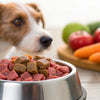How to Switch My Dog to Raw Food: A Comprehensive Guide for Pet Owners
- Houndsy
Table of Contents
- Introduction
- Why Choose a Raw Diet for Your Dog?
- Preparing for the Transition
- Transitioning to Raw: Key Strategies
- What to Expect After Transitioning
- Nutritional Considerations and Common Mistakes
- Conclusion
Introduction
Did you know that nearly 60% of dogs in the United States are overweight or obese? As loving pet parents, it's our responsibility to ensure our furry companions are healthy, happy, and thriving. One significant way we can achieve this is by reevaluating their diets. If you've been contemplating how to switch your dog to raw food, you're in the right place.
Feeding your dog a raw diet can offer numerous health benefits, from shinier coats to improved energy levels. However, navigating the transition from kibble to raw can feel daunting. By the end of this article, we’ll provide you with a clear, actionable roadmap on how to switch to a raw food diet. We’ll discuss the pros and cons, various strategies for transitioning, and what to expect during the adjustment period.
Let's take this opportunity to reflect on our current dog feeding routines. Are they meeting our furry friends' nutritional needs? Are we ready to embrace a healthier alternative? This guide aims to empower us to make informed choices for our pets, ultimately leading to healthier, happier lives.
Why Choose a Raw Diet for Your Dog?
Before we delve into the how-to's, it's important to understand why we might choose a raw diet in the first place. Many pet parents are drawn to raw feeding for the following reasons:
- Nutrient-Dense: Raw diets are higher in protein and nutrients than their kibble counterparts, often leading to better overall health.
- Digestive Benefits: Many dogs experience improved digestion on a raw diet, which can lead to smaller, less odorous stools.
- Improved Energy Levels: Pet owners frequently report observing their dogs with increased energy and greater enthusiasm during playtime.
- Healthier Skin and Coat: A switch to raw often results in shinier and healthier fur. It’s a visible indicator of a dog's overall well-being.
- Reduced Allergies and Sensitivities: A raw diet can help alleviate certain allergies that may be exacerbated by fillers and processed ingredients found in commercial pet foods.
Understanding these benefits can motivate us to explore how to make a successful transition to a raw diet.
Preparing for the Transition
Educate Yourself
Before making any dietary changes, it's essential to educate ourselves about raw feeding. This includes understanding the nutritional requirements for dogs and familiarizing ourselves with the different types of raw diets, including:
- Complete and Balanced Premade Diets: These options follow AAFCO guidelines and are designed to meet all nutritional needs without added supplements.
- Homemade Raw Diets: If you prefer preparing food for your dog, ensure that you have a well-researched plan that includes the right balance of protein, fat, vitamins, and minerals.
Researching raw feeding involves reading reputable sources, connecting with knowledgeable vets or nutritionists, and engaging with other pet owners in the raw feeding community.
Consult Your Veterinarian
Before embarking on the change, it’s wise to consult with your veterinarian. They can offer guidance on how to best transition your dog based on their health, age, and weight. Candid discussions about your dog's medical history and specific dietary needs will help set a solid foundation for the upcoming transition.
Transitioning to Raw: Key Strategies
Once you're aptly prepared to make the switch, there are two primary methods to transition your dog to a raw diet: the slow and gradual approach or the cold-turkey switch. Each method comes with benefits and considerations to help you determine what might work best for your pet.
The Gradual Transition Method
Taking a gradual approach is often recommended, particularly for dogs with sensitive stomachs, senior dogs, or those who have been eating kibble for an extended period. Here’s a breakdown of how to implement this method effectively:
-
Start Small: Introduce a small portion of raw food into your dog's diet alongside their existing kibble. A common starting point is to replace about 25% of their meal with raw food. Monitor their reaction and ensure that stools remain firm.
-
Increase Gradually: Over the next 7-14 days, gradually increase the proportion of raw food while decreasing kibble. Follow a weekly schedule:
- Week 1: 75% kibble, 25% raw
- Week 2: 50% kibble, 50% raw
- Week 3: 25% kibble, 75% raw
- Week 4: 100% raw
-
Monitor Stools: Throughout the transition, keep an eye on your dog's stools. If there are signs of digestive upset (loose stools or diarrhea), slow the transition and consider increasing the kibble proportion again.
-
Introduce Variety: After your dog adjusts to exclusively raw food, consider introducing different protein sources. Rotating proteins not only keeps meal times interesting but also ensures a well-rounded nutritional profile.
The Cold-Turkey Method
For some dogs—especially those in good health—an immediate switch to raw can be a viable option. Here’s how to manage a cold-turkey transition safely:
-
Fasting: Prior to switching to raw food, consider fasting your dog for 12-24 hours. This can help clear their digestive system and prepare their gut for the new food. Always offer fresh water during this fasting period.
-
Start with Raw: On the next meal, present 100% raw food. Initially, it may be beneficial to use simpler proteins, like chicken or turkey, to ease them into the diet.
-
Monitor Closely: After the switch, watch for digestive issues. Be prepared to consult with your vet if your dog shows signs of distress.
-
Eager Eating: Raw food is generally more appealing to dogs, so you may notice your pup eager and enthusiastic at meal times.
Combining Methods
Consider a hybrid approach that combines both gradual and cold-turkey methods, particularly for picky dogs or those who may not have been fed raw foods before. Here’s how to do it:
-
Treat-First Approach: Start by incorporating raw food treats gradually into their existing meals. Observe for any adverse reactions and keep track of their stool quality.
-
Separate Mealtimes: Initially offer raw as a separate meal from kibble to help assess how they handle the transition. Gradually, work them toward combined meals.
-
Proince Show-Stoppers: If your dog shows disinterest in raw upon first introduction, try warming their food slightly or mixing in enticing toppings like bone broth. These efforts can boost palatability.
What to Expect After Transitioning
As we move forward with our dogs on a raw diet, a few adjustments are to be expected. Here are some common changes we might observe during the transition:
-
Digestive Adaptation: Initially, dogs may experience adjustments in their stool consistency. While raw diets lead to smaller, firmer stools, you may notice looser stools temporarily as their digestive systems adapt to digesting fresh food.
-
Hydration Reassessments: The higher moisture content in raw food means our pups may naturally drink less water. Always ensure fresh water is available, but watch for adequate hydration levels.
-
Energized Behavior: Most dogs exhibit heightened energy levels and excitement around mealtimes once they fully transition to a raw diet. This enthusiasm often indicates that they find the food more appealing than kibble.
-
Allergy Relief: Many pet owners report fewer allergy symptoms after switching to a fresh raw diet. This observation is positive news for those with dogs who have previously struggled with food sensitivities.
Nutritional Considerations and Common Mistakes
Switching to raw doesn't mean we can neglect our dog’s nutritional needs. Here are key considerations to keep in mind:
-
Focus on Balance: A balanced raw diet includes proteins, organs, and bones. Follow guidelines from reputable sources to ensure nutritional adequacy.
-
Avoid Overcomplicating: Don’t let the intricacies of raw feeding overwhelm you. Keep it simple while ensuring variety and balance in types protein.
-
Don’t Rush the Transition: Rushing can cause digestive distress and may lead to negative associations with the new food.
-
Monitor for Allergies: Initially introduce new protein sources one at a time to identify any potential allergies or sensitivities.
Conclusion
Navigating the switch to a raw food diet can undoubtedly seem overwhelming, but with informed preparation, we can ensure a successful transition that benefits our canine companions in many ways. By understanding the right methods of transition, what to expect, and monitoring our dogs' reactions, we can create an enriching dietary environment that enhances their health and vitality.
Are we ready to take the plunge into a raw feeding journey that can potentially improve our beloved pets' lives? If so, we can ensure their feeding moments remain elevated, consistent, and beautiful—just like their love for us. To further enhance the way that we manage feeding time, consider exploring the Houndsy Kibble Dispenser. Not only does it streamline the feeding process, but its modern design fits beautifully within our homes while ensuring our pets are nourished with love.
FAQ
Will a raw diet benefit all dogs?
While many dogs benefit from a raw diet, it’s essential to tailor the approach based on individual health needs. Always consult with your veterinarian before making dietary changes.
How can I tell if my dog is adjusting well to the raw food?
Monitoring their energy levels, coat condition, digestion, and appetite will provide insight. A gradual decrease in stool size and firmness is generally a good sign.
Is raw food safe for puppies?
Puppies can benefit from a raw diet, but it's crucial to ensure the food is balanced for their growth needs. Consult with a veterinarian for appropriate options suited for puppies.
Can I mix raw food with kibble?
While some sources discourage mixing raw and kibble, many dogs can handle small amounts together. Keep an eye on how your pup reacts if choosing this method.
What if my dog refuses the raw food?
Start by warming the food slightly or adding enticing toppers such as bone broth. If necessary, consider revisiting your dog’s individual taste preferences for proteins and recipes.
Transitioning to a raw diet can be a rewarding step towards optimal health for our canine companions. Let's embrace this journey for their well-being together!












